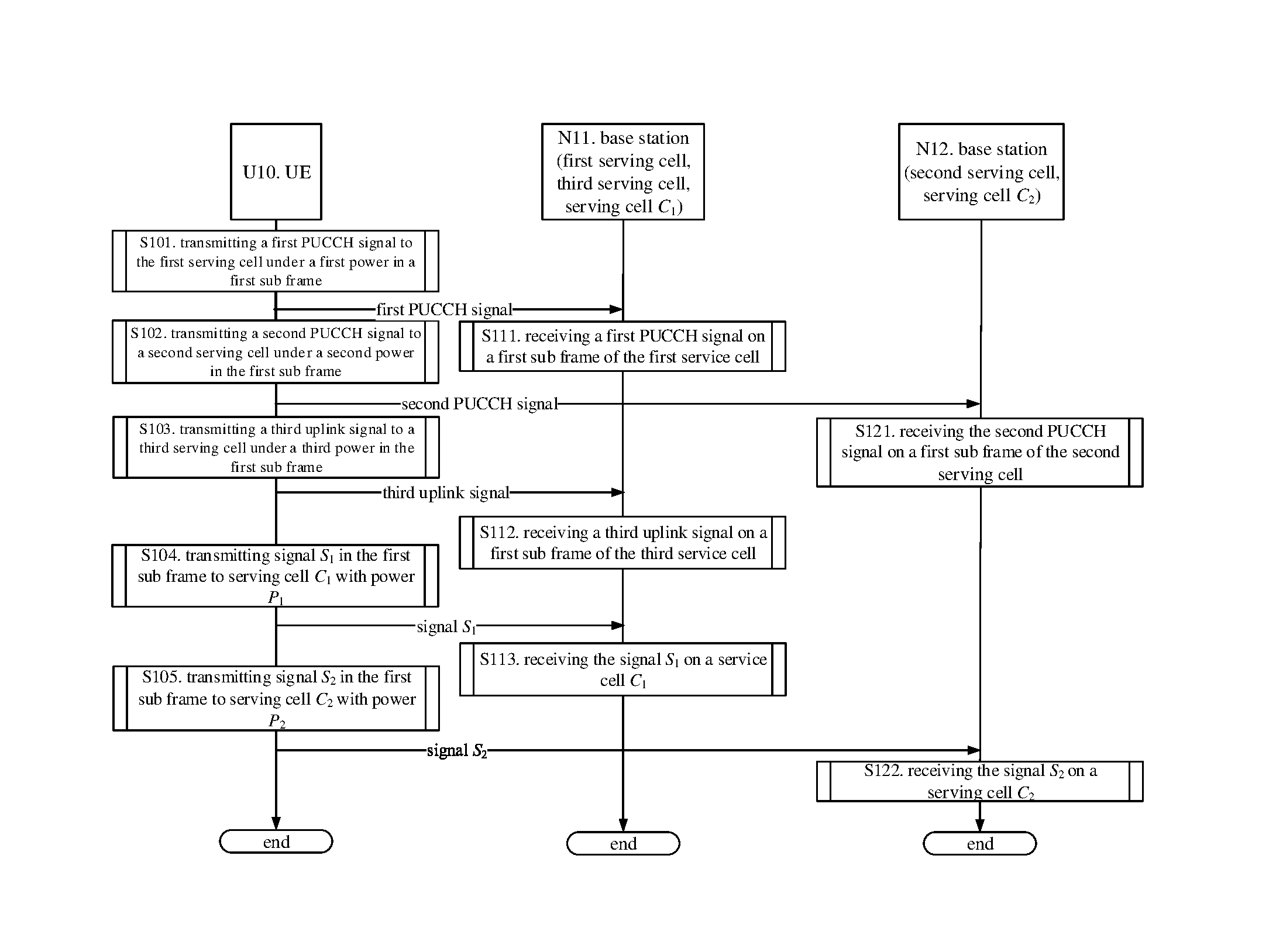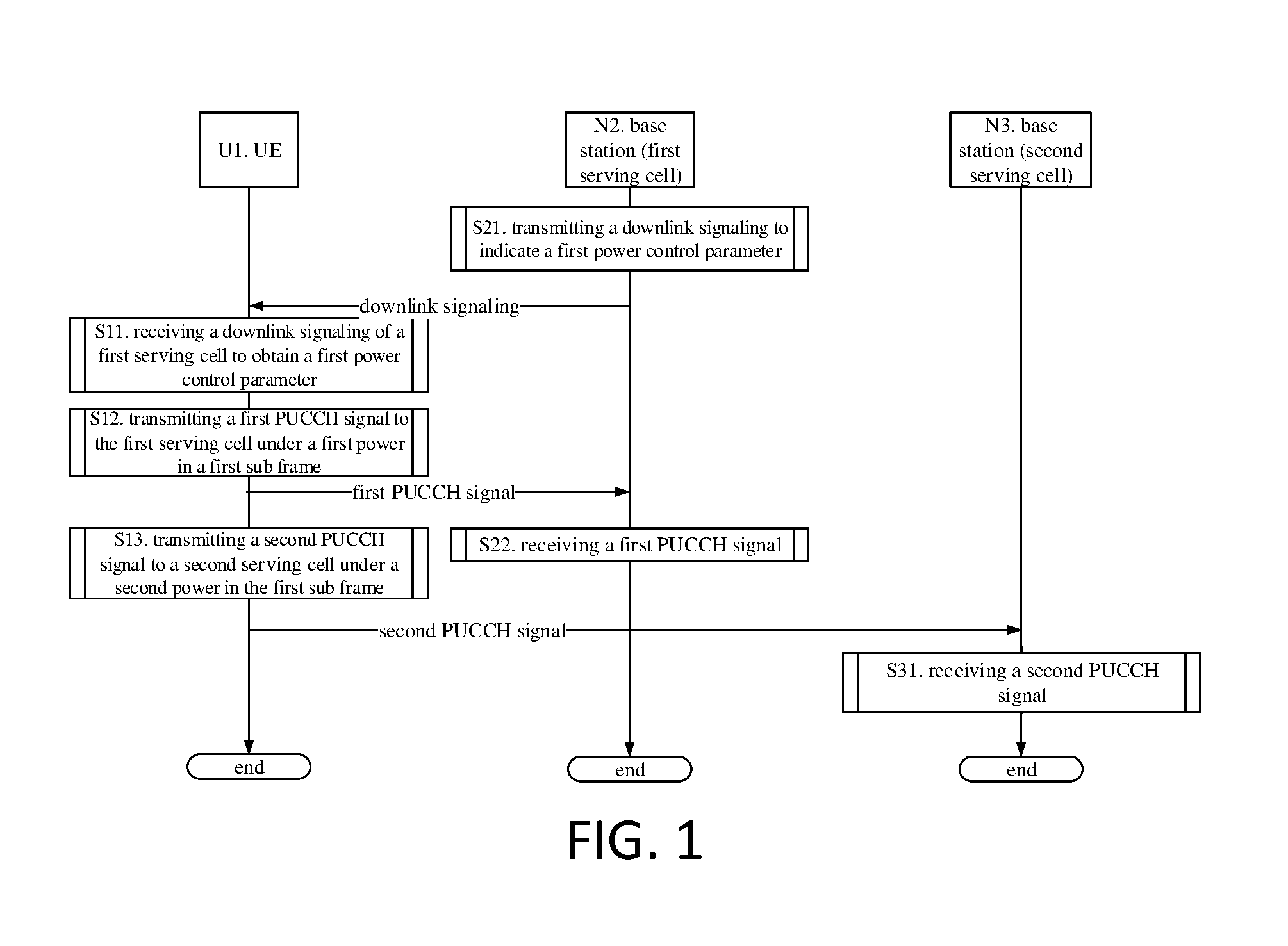Method and device for multiple-serving-cell connectivity for ue and base station
a technology of ue and base station, applied in the field of dual-connectivity communication uplink power control methods and devices, can solve problems such as the problem of solving the power reduction of the pucch signal transmitted by the secondary base station, and achieve the effect of maintaining maximum compatibility and robustness of the ue connection
- Summary
- Abstract
- Description
- Claims
- Application Information
AI Technical Summary
Benefits of technology
Problems solved by technology
Method used
Image
Examples
embodiment i
[0082]Embodiment I illustrates a flowchart of transmitting PUCCH signals on a primary cell and a secondary cell simultaneously, as shown in FIG. 1. In FIG. 1, the base station N2 is a maintaining base station of the first serving cell, i.e. a primary base station, and the base station N3 is a maintaining base station of the second serving cell, i.e. a secondary base station.
[0083]For the UE U1, in step S11, the method involves receiving a downlink signaling of a first serving cell to obtain a first power control parameter; in step S12, the method involves transmitting a first PUCCH signal to the first serving cell under a power P1PUCCH in a first sub frame; in step S13, the method involves transmitting a second PUCCH signal to a second serving cell under a power P2PUCCH in the first sub frame.
[0084]For the base station N2, in step S21, the method involves transmitting a downlink signaling to indicate a first power control parameter; in step S22, the method involves receiving a first...
embodiment ii
[0093]Embodiment II is a flowchart of transmitting uplink signals on three cells simultaneously, as shown in FIG. 2. In Embodiment II, the base station N5 is a maintaining base station of a first serving cell and a third serving cell, and the base station N5 is a primary base station. The base station N6 is a maintaining base station of a second serving cell, and the base station N6 is a secondary base station.
[0094]For the UE U4, in step S41, the method involves receiving a downlink signaling of a first serving cell to obtain a first power control parameter; in step S42, the method involves transmitting a first PUCCH signal to the first serving cell under a power P1PUCCH in a first sub frame; in step S43, the method involves transmitting a second PUCCH signal to a second serving cell under a power P2PUCCH in the first sub frame; in step S44, the method involves transmitting a third uplink signal to a third serving cell under a power P3PUSCH_UCI in the first sub frame.
[0095]For the ...
embodiment iii
[0101]Embodiment III is a flowchart of transmitting a backhaul signaling to exchange power control parameter through the interface between the base stations, as shown in FIG. 3. In Embodiment III, the base station N8 is a maintaining base station of a first serving cell, a serving cell C1 and a third serving cell, and the base station N8 is a primary base station. The base station N9 is a maintaining base station of a serving cell C2 and a second serving cell, and the base station N6 is a secondary base station.
[0102]For the UE U7, in step S71, the method involves receiving a downlink signaling of a first serving cell to obtain a first power control parameter; in step S72, receiving a downlink signaling of a second serving cell to obtain a second power control parameter.
[0103]For the base station N8, in step S81, the method involves transmitting a downlink signaling on the first serving cell to indicate a first power control parameter; in step S82, the method involves transmitting a...
PUM
 Login to View More
Login to View More Abstract
Description
Claims
Application Information
 Login to View More
Login to View More - R&D
- Intellectual Property
- Life Sciences
- Materials
- Tech Scout
- Unparalleled Data Quality
- Higher Quality Content
- 60% Fewer Hallucinations
Browse by: Latest US Patents, China's latest patents, Technical Efficacy Thesaurus, Application Domain, Technology Topic, Popular Technical Reports.
© 2025 PatSnap. All rights reserved.Legal|Privacy policy|Modern Slavery Act Transparency Statement|Sitemap|About US| Contact US: help@patsnap.com



